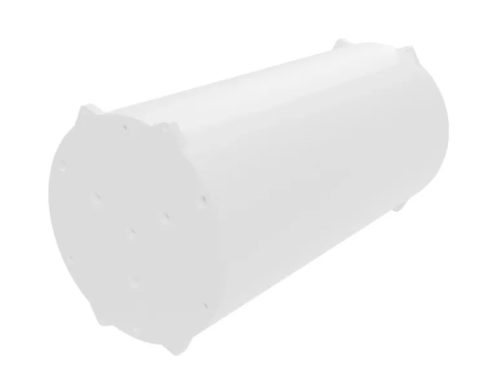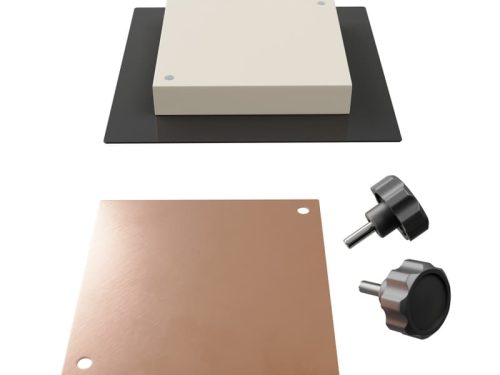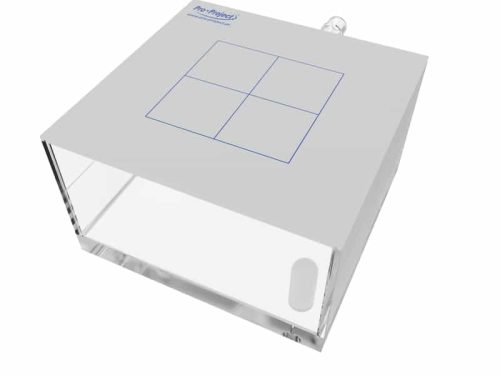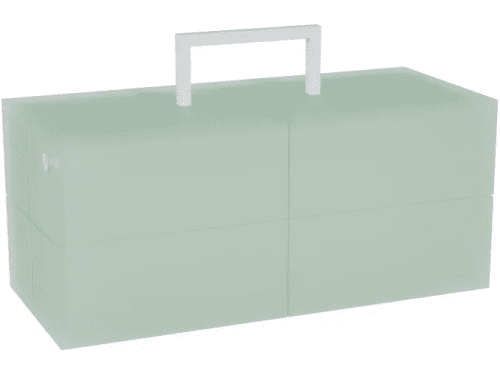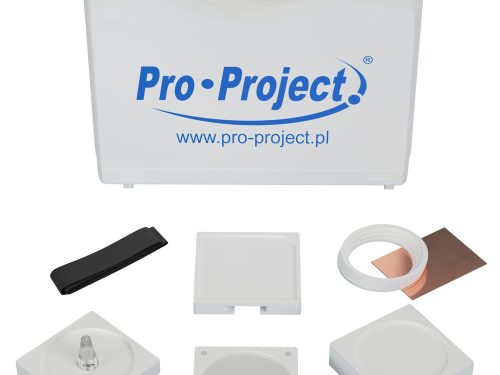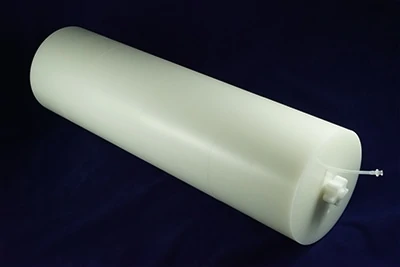-
 The Pro-RT ED phantom is used to account for tissue heterogeneity in radiotherapy treatment planning. It can be used to define the precise correlation of CT data to the electron density of various tissues. The phantom consists of two nested disks that represent the head and abdomen. Nine different tissue equivalent electron density plugs can be positioned at 17 different locations within the scan field. Included is a water vial plug that can be filled with any fluid. Optional distance marker plugs enable quick assessment of the CT scanner’s distance measurement accuracy.
The Pro-RT ED phantom is used to account for tissue heterogeneity in radiotherapy treatment planning. It can be used to define the precise correlation of CT data to the electron density of various tissues. The phantom consists of two nested disks that represent the head and abdomen. Nine different tissue equivalent electron density plugs can be positioned at 17 different locations within the scan field. Included is a water vial plug that can be filled with any fluid. Optional distance marker plugs enable quick assessment of the CT scanner’s distance measurement accuracy. -
 Pro-RT IsoBeam This is a multifunctional, precision quality assurance tool for daily, weekly or monthly quality assessments of all mechanical and geometrical treatment parameters of linear accelerators or teletherapy units. It is designed to easily and accurately check collimator isocentricity, gantry isocentricity, table isocentricity, collimator field size accuracy, radiation/light field congruence, isocenter rotational stability, ODI accuracy and laser light alignments.
Pro-RT IsoBeam This is a multifunctional, precision quality assurance tool for daily, weekly or monthly quality assessments of all mechanical and geometrical treatment parameters of linear accelerators or teletherapy units. It is designed to easily and accurately check collimator isocentricity, gantry isocentricity, table isocentricity, collimator field size accuracy, radiation/light field congruence, isocenter rotational stability, ODI accuracy and laser light alignments. -
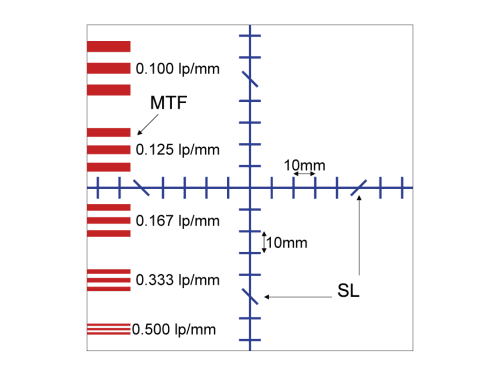 This phantom is designed for quality control of a CT simulator, which usually consists of a CT scanner, virtual symulator software and a laser marking device (marking the centre of target volume). Since geometrical planning is the core of CT simulation, periodic quality control is essential for maintaining optimum image quality and patient care. The phantom allows performing detailed geometry and table movement tests as well as image quality assessment - low contrast resolution and high contrast detectability.
This phantom is designed for quality control of a CT simulator, which usually consists of a CT scanner, virtual symulator software and a laser marking device (marking the centre of target volume). Since geometrical planning is the core of CT simulation, periodic quality control is essential for maintaining optimum image quality and patient care. The phantom allows performing detailed geometry and table movement tests as well as image quality assessment - low contrast resolution and high contrast detectability. -
 Simple to use and economic tool to perform true spatial alignment and coincidence tests on IGRT systems. Pro-RT Align-Cube contains engraved markings on the exterior and radiographic markers inside. The isocenters of both the OBI and the EPID can be checked for true spatial alignment and coincidence with that of the treatment beam. The phantom ensures the accuracy of linacs’ image-guidance systems, including CBCT, x-ray volumetric imaging (XVI) and on-board imaging (OBI). It can be used to test: 3D cone beam registration kV and MV system coincidence kV and MV projection images laser and light field coincidence weekly remote table adjustments
Simple to use and economic tool to perform true spatial alignment and coincidence tests on IGRT systems. Pro-RT Align-Cube contains engraved markings on the exterior and radiographic markers inside. The isocenters of both the OBI and the EPID can be checked for true spatial alignment and coincidence with that of the treatment beam. The phantom ensures the accuracy of linacs’ image-guidance systems, including CBCT, x-ray volumetric imaging (XVI) and on-board imaging (OBI). It can be used to test: 3D cone beam registration kV and MV system coincidence kV and MV projection images laser and light field coincidence weekly remote table adjustments -
 This stability (agar) phantom consists of a cylindrical phantom and agar material inside. Using this phantom a Signal to Noise Ratio, Signal Fluctuation to Noise Ratio, drift, and other imaging measures over a 100-volume or 200-volume fMRI scan can be performed. The agar phantom has characteristics similar to the T2 measures of a human head, but provides no change in signal. The T1 and T2 characteristics of the agar phantom at 3T are ~900 ms T1 and 30 ms T2.
This stability (agar) phantom consists of a cylindrical phantom and agar material inside. Using this phantom a Signal to Noise Ratio, Signal Fluctuation to Noise Ratio, drift, and other imaging measures over a 100-volume or 200-volume fMRI scan can be performed. The agar phantom has characteristics similar to the T2 measures of a human head, but provides no change in signal. The T1 and T2 characteristics of the agar phantom at 3T are ~900 ms T1 and 30 ms T2. -
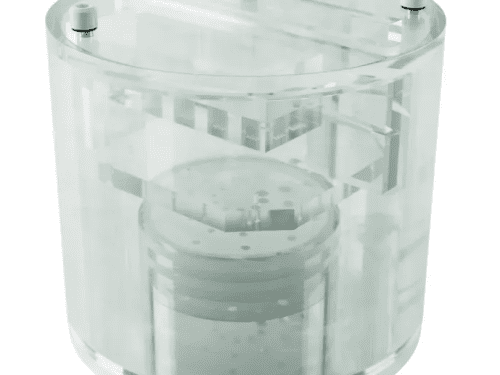 ACR accredited Medium MRI phantom for comprehensive evaluation of critical imaging parameters of magnetic resonance imaging (MRI) in a time efficient manner. The phantom can be used for the measurement of absolute values for calibration purposes. However, its design is optimized for time efficient daily quality assurance too.
ACR accredited Medium MRI phantom for comprehensive evaluation of critical imaging parameters of magnetic resonance imaging (MRI) in a time efficient manner. The phantom can be used for the measurement of absolute values for calibration purposes. However, its design is optimized for time efficient daily quality assurance too. -
 Large MRI phantom for comprehensive evaluation of critical imaging parameters of magnetic resonance imaging (MRI) in a time efficient manner. The phantom can be used for the measurement of absolute values for calibration purposes. However, its design is optimized for time efficient daily quality assurance too.
Large MRI phantom for comprehensive evaluation of critical imaging parameters of magnetic resonance imaging (MRI) in a time efficient manner. The phantom can be used for the measurement of absolute values for calibration purposes. However, its design is optimized for time efficient daily quality assurance too. -
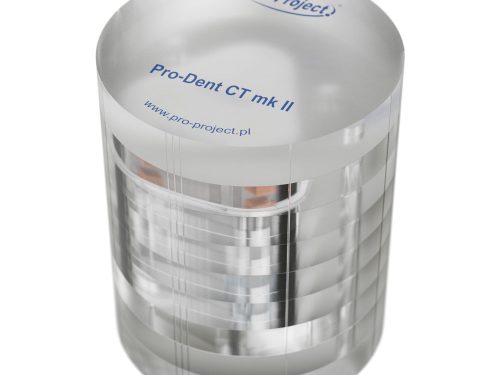 The new Pro-Dent CT mk II phantom is a versatile quality control tool of dental Cone-Beam CT, Dental Volume Tomography (DVT) and other 3D imaging devices according to the Radiation Protection Report no 172 by SEDENTEXCT. The phantom consists of a main PMMA cylinder that houses modules with different test objects. Thanks to this design, you can perform tests with devices with a small FOV at different positions in the 160 mm phantom.
The new Pro-Dent CT mk II phantom is a versatile quality control tool of dental Cone-Beam CT, Dental Volume Tomography (DVT) and other 3D imaging devices according to the Radiation Protection Report no 172 by SEDENTEXCT. The phantom consists of a main PMMA cylinder that houses modules with different test objects. Thanks to this design, you can perform tests with devices with a small FOV at different positions in the 160 mm phantom. -
 A simple phantom the quality assurance of geometric distortion and spatial resolution of gamma cameras. Array of holes, which when filled with activity, allows to measure point-to-point distances and Point Spread Function (PSF) - spatial resolution - at each point and its homogeneity across the entire Field of View.
A simple phantom the quality assurance of geometric distortion and spatial resolution of gamma cameras. Array of holes, which when filled with activity, allows to measure point-to-point distances and Point Spread Function (PSF) - spatial resolution - at each point and its homogeneity across the entire Field of View. -
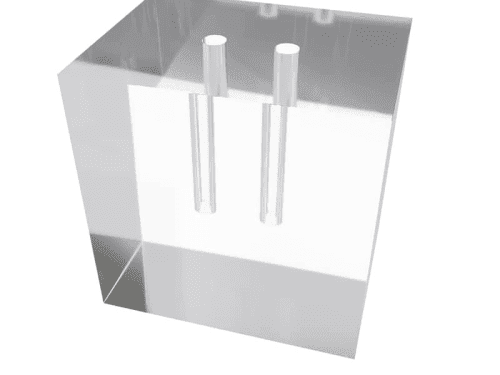 This scatter phantom simulates in-vivo forward and backscatter characteristics of 99mTc gamma rays for the extrinsic measurement of a scintillation camera’s deadtime. The phantom produces a spectrum typical of that observed from 99mTc in the myocardium. Reference: Ralph Adams, Gerald J. Hine, and C. Duane Zimmerman, “Deadtime Measurements in Scintillation Cameras Under Scatter Conditions Simulating Quantitative Nuclear Cardiography,” The Journal of Nuclear Medicine, 19 (1978), 538-544.
This scatter phantom simulates in-vivo forward and backscatter characteristics of 99mTc gamma rays for the extrinsic measurement of a scintillation camera’s deadtime. The phantom produces a spectrum typical of that observed from 99mTc in the myocardium. Reference: Ralph Adams, Gerald J. Hine, and C. Duane Zimmerman, “Deadtime Measurements in Scintillation Cameras Under Scatter Conditions Simulating Quantitative Nuclear Cardiography,” The Journal of Nuclear Medicine, 19 (1978), 538-544. -
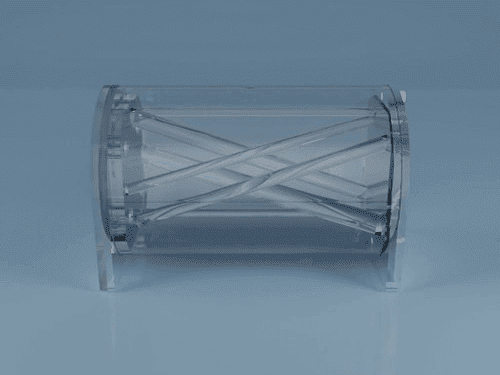 The Phantom designed for a simple and cost effective verification of image alignment and distortion in hybrid scanning systems like PET/CT or NM/CT. It consists of a cylinder that can be filled with a variety of fluids. Several non-parallel rods of varying diameter and at certain angles in relation to the phantom’s axes run the entire length of the cylinder.
The Phantom designed for a simple and cost effective verification of image alignment and distortion in hybrid scanning systems like PET/CT or NM/CT. It consists of a cylinder that can be filled with a variety of fluids. Several non-parallel rods of varying diameter and at certain angles in relation to the phantom’s axes run the entire length of the cylinder.

